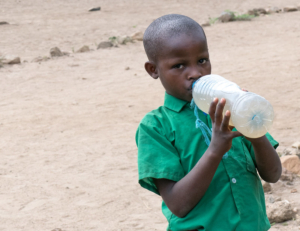Combating the Worldwide Water Crisis
 Currently, there is a worldwide water crisis, as 771 million people face a total lack of access to safe water. According to the World Health Organization (WHO), one in three people worldwide does not have access to safe drinking water. The global water crisis has far-reaching consequences for communities across the globe, such as contaminated water-borne diseases, health issues like dehydration, vomiting and diarrhea, as well as economic difficulties. Families may have to spend a significant amount of their income on buying bottled water or traveling lost distances to collect water, which can make it challenging for them to fulfill other basic needs, including food, shelter and education.
Currently, there is a worldwide water crisis, as 771 million people face a total lack of access to safe water. According to the World Health Organization (WHO), one in three people worldwide does not have access to safe drinking water. The global water crisis has far-reaching consequences for communities across the globe, such as contaminated water-borne diseases, health issues like dehydration, vomiting and diarrhea, as well as economic difficulties. Families may have to spend a significant amount of their income on buying bottled water or traveling lost distances to collect water, which can make it challenging for them to fulfill other basic needs, including food, shelter and education.
Affecting Women and Girls
In addition, water scarcity disproportionately affects women and girls because they often experience the burden of collecting water. Spending hours of their days walking to obtain water for their families often limits their opportunities for education, work and social activities. Unsafe sanitation also poses a threat to women and girls, as they face a higher risk of abuse and assault when having to use outdoor toilets or sharing facilities with men and boys.
In 2009, actor Matt Damon and engineer Gary White founded Water.org, a nonprofit organization that aims to provide access to safe water and sanitation to people in developing countries. Water.org combats the global water crisis across 11 countries through affordable market-based solutions.
Global Water Crisis in Numbers
The following five statistics put into perspective the pervasiveness and danger of the water crisis.
- Approximately 2 billion people worldwide lack access to clean water, and 3.4 billion do not have proper sanitation facilities, according to Water for People.
- According to reports, one in six health care facilities does not have handwashing stations or toilets, which puts millions of people seeking help for health issues at an even greater risk.
- Water for People reports that “3.4 million deaths occur each year from water-related diseases.”
- On average, women living in rural Africa walk 3.7 miles every day to collect water and carry 40 pounds of it back to their families.
- By 2025, half of the global population could live in regions confronted with water scarcity. Furthermore, by 2040, over a quarter of the world’s children will “live in areas of extremely high water stress.”
Water.org combats the global water crisis with urgency and innovation in an effort to reduce the grand scale of water scarcity worldwide.
Water.org’s Mission and Formula
Working in 11 countries across Africa, Asia and Latin America, Water.org combats the global water crisis through market-based solutions to empower communities and make access to safe water and sanitation sustainable. The organization offers two loan programs—WaterCredit and WaterEquity—that have distinct goals and serve different groups of borrowers.
WaterCredit provides small loans to families in developing countries, who lack access to traditional credit and cannot afford to pay upfront for water and sanitation solutions, such as wells, pumps, and toilets. Families repay these loans over time, with the expectation that the borrower will eventually become financially stable enough (now that they can devote their time to other efforts besides collecting water) to repay the loan in full.
The WaterEquity program is an impact investing project that provides funding for water and sanitation enterprises to scale solutions to reach more people. Investors offer small loans for water and sanitation that are repaid over time, potentially receiving a financial return.
WaterEquity helps to attract private capital to the water and sanitation sector, promoting innovation and expanding access to safe water and sanitation. According to Water.org, “The investor can potentially receive a financial return, or re-invest to further their social impact.” This initiative provides sustainable solutions to the global water crisis and offers an “attractive risk-return profile to investors.”
Impact and Achievements
As of 2023, Water.org has provided access to safe water and sanitation to over 55 million people in 11 countries, according to its website. Water.org’s primary initiative, WaterCredit, has helped to mobilize over $4.4 billion in capital for water and sanitation projects. Water.org has enabled communities around the globe to take control of their own solutions and break the cycle of poverty caused by a lack of access to safe water and sanitation.
India’s water crisis is particularly severe. Nearly 600 million people face high to extreme water stress, and “nearly 200,000 people in India die each year due to inadequate access to safe water.” In addition, by 2030, the water demand in India could be “twice the available supply.”
On the bright side, Water.org’s efforts against the global water crisis include 31 local partners in India. Water.org has helped more than 21 million people gain access to safe water and sanitation.
The organization combats the global water crisis through innovative solutions that generate long-lasting and life-changing effects for families worldwide. Overall, the continued efforts of organizations like Water.org present hope for a future where safe water and sanitation are accessible to all.
– Skye Connors
Photo: Flickr
